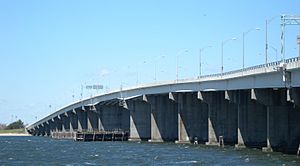Cross Bay Veterans Memorial Bridge facts for kids
Quick facts for kids Cross Bay Veterans Memorial Bridge |
|
|---|---|
 |
|
| Coordinates | 40°35′29″N 73°49′11″W / 40.591497°N 73.819614°W |
| Carries | Cross Bay Boulevard |
| Crosses | Jamaica Bay |
| Locale | Broad Channel and Rockaway Peninsula, in New York City |
| Maintained by | MTA Bridges and Tunnels |
| Characteristics | |
| Total length | 3,000 feet (910 m) |
| Longest span | 275 feet (84 m) |
| Clearance below | 55 feet (17 m) |
| History | |
| Opened | May 28, 1970 |
| Statistics | |
| Daily traffic | 24,150 (2016) |
| Toll | As of March 31, 2019, $4.75 (Tolls By Mail and non-New York E-ZPass); $2.29 (New York E-ZPass) |
| Lua error in Module:Location_map at line 420: attempt to index field 'wikibase' (a nil value). | |
The Cross Bay Veterans Memorial Bridge is a special toll bridge in New York City. It helps people travel across Jamaica Bay in Queens. This bridge connects two areas: Broad Channel and the Rockaway Peninsula. It's an important road that carries Cross Bay Boulevard.
Contents
History of the Cross Bay Bridge
Building the First Bridge
Back in 1917, people started planning a bridge to connect Howard Beach with Rockaway Beach. The goal was to make it faster for people from Manhattan to reach the Rockaways. Construction began in 1923. The bridge was designed by a company called Madigan-Hyland.
The first Cross Bay Bridge opened in 1925. It cost about $7 million to build. This bridge was part of a bigger plan to make Jamaica Bay a fun place for recreation, not just for industry.
The Second Bridge and Upgrades
Even though the first bridge was meant to handle a lot of cars, it became very crowded by 1929. So, a new bridge was built in the same spot. This second bridge opened on June 3, 1939. It was a low-level bascule bridge, which means it could open to let boats pass.
This new bridge was much wider than the first one. It also had special ramps to connect to Beach Channel Drive and the Cross Bay Parkway. After it was finished, an official named Harry Taylor said it had turned the old beach area into a "modern playground."
The Current High-Level Bridge
The bridge was rebuilt again and opened on May 28, 1970. This is the bridge you see today. It's a high-level fixed bridge, meaning it doesn't open for boats. It's built 55 feet high, so boats can easily pass underneath without delays.
The current bridge has six lanes for traffic and a sidewalk on one side. The Triborough Bridge and Tunnel Authority operates this bridge.
Paying to Cross the Bridge
Tolls and E-ZPass
The Cross Bay Veterans Memorial Bridge is a toll bridge, which means drivers pay a fee to cross it. As of March 31, 2019, the toll for a car is $4.75 if you pay by mail.
If you use an E-ZPass transponder from New York, the toll is less, about $2.29 per car. If your E-ZPass is from another state, you pay the higher toll-by-mail rate.
Discounts for Local Residents
People who live in the Rockaways and Broad Channel get a special discount. If they have a New York E-ZPass and register for the program, they pay less. For example, some residents pay about $1.49 per car.
Before 2010, residents of these areas could cross the bridge for free. Now, they pay a small fee, but they still get a good discount. If they cross more than twice in 24 hours, they are not charged for those extra crossings.
Cashless Tolling System
Since April 30, 2017, the bridge uses a modern system called open-road cashless tolling. This means there are no more tollbooths where you stop to pay cash.
Instead, cameras are mounted on overhead structures. These cameras take a picture of your license plate if you don't have an E-ZPass. Then, a bill for the toll is mailed to the car's owner. If you have an E-ZPass, sensors read your transponder as you drive by. This makes crossing the bridge much faster and smoother.

